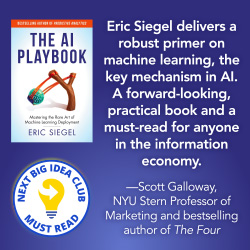For more from James Taylor, see his presentation on Decision Modeling for Predictive Analytic Projects at Predictive Analytics World for Business, March 29-April 2, 2015 in San Francisco.
Back in May of last year, Wayne Eckerson published “Making Predictive Analytics Pervasive“. It’s a great report with some really useful data but one of the key headline result is that implementation rates are not rising – in fact fewer organizations are reporting successful implementation of predictive analytics (from 21% to 18%). This despite the massive increase in awareness of predictive analytics as part of the “Big Data” wave and continued good results for those that succeed with predictive analytics projects continuing to show high ROI.
Wayne identifies a number of challenges that I have paraphrased:
- Business owners can’t tell where predictive analytics will help – they need help figuring out where the ROI is and then proving it later.
- He notes a 50% increase in time spent defining projects so clearly this is a challenge for folks and probably contributes to resource and scaling issues.
- Organizations have challenges finding skilled analysts and scaling their efforts as a result.
- Getting users to trust and use predictive analytics remains a challenge as does the time it takes to deploy an analytic model.
If these challenges sound familiar you should look into decision modeling, especially decision requirements models built using the new Decision Model and Notation standard. While it’s not a magic bullet, it has shown tremendous value in these areas in projects we have done with analytic teams across banking, insurance, manufacturing, healthcare and high tech.
 So what is a decision requirements model? A decision requirements model describes the structure of the decision making involved in a decision you make over and over again like approving claims, pricing deals, making marketing offers or picking suppliers. It breaks down the decision-making and identifies the information needed to make the decision as well as the knowledge, the know-how, you need to make it effectively and correctly. It connects these elements – decisions, information and knowledge – into a requirements network.
So what is a decision requirements model? A decision requirements model describes the structure of the decision making involved in a decision you make over and over again like approving claims, pricing deals, making marketing offers or picking suppliers. It breaks down the decision-making and identifies the information needed to make the decision as well as the knowledge, the know-how, you need to make it effectively and correctly. It connects these elements – decisions, information and knowledge – into a requirements network.
A decision requirements model helps you succeed with predictive analytics by:
- Enabling business owners to describe their decision making and so identify exactly where in that decision making predictive analytics would help – “if only we knew which customers would churn we could make this bit of the decision more accurately”.
- DMN is a standard modeling notation that is coming to the Business Analyst Body of Knowledge or BABOK in v3 and has been shown to be usable by business analysts. This allows teams to build these models without needing scarce data science resources initially – they only need to be brought in once the problem is well defined.
- Because it’s a well defined approach with a simple notation requirements can be specified quickly and accurately, saving time and resources.
- Decision requirements models can be linked to KPIs and metrics so it is clear which metrics will improve if the decision making does. This helps establish how the predictive analytics will add value and shows how to track and measure their ROI later.
- By clearly showing how the proposed analytic will impact decision-making they make it easier to plan and execute on model deployment and ensure that business users will use analytic models because they can see clearly where they fit and why they will help.
- Finally using a common notation across all analytic projects allows projects to be prioritized relative to each other and allows an organization to gradually build up the kind of decision inventory they will need over time (see this article in the WSJ by Tom Davenport for instance).
We have a number of clients succeeding in their predictive analytics efforts thanks to decision modeling and you can too. There’s more on decision modeling with DMN in our white paper Decision Modeling with DMN and don’t forget you can sign up for the free 3-user version of our decision modeling software, DecisionsFirst Modeler also. And don’t forget Tom Debevoise and I have a new book out on process and decision modeling using BPMN and DMN.
By: James Taylor, CEO, Decision Management Solutions
Originally published at http://smartdatacollective.com






